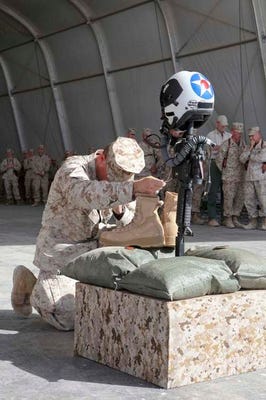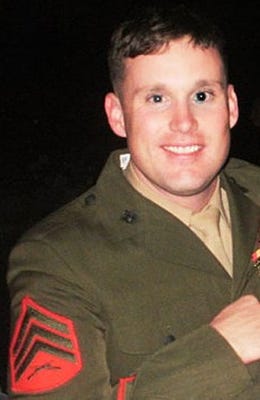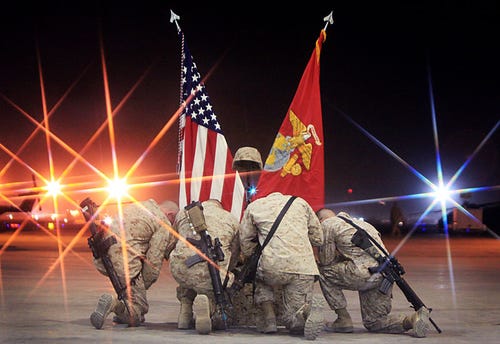source GAIA package: Sx_MilitaryTimes_M6201210210190325_5675.zip Origin key: Sx_MilitaryTimes_M6201210210190325 imported at Fri Jan 8 18:18:07 2016
Tell us
Share your thoughts on Lt. Col. Raible's heroism. Send us a letter to the editor: marinelet@marinecorpstimes.com
CAMP BASTION, Afghanistan — Cpl. Cecil Burkes was on the flight line here tinkering with an MV-22 Osprey when he heard a fellow Marine screaming over the radio. He pulled his head out of the aircraft — just in time to see tracer rounds streaking at him through the night sky.
 Burkes, 23, didn't know it at the time, but 15 insurgents had penetrated the wire at Bastion. Working in three teams of five, they used assault rifles, rocket-propelled grenades and other weapons in a coordinated attack that killed two Marines, wounded at least nine other coalition personnel and destroyed six U.S. AV-8B Harrier jets, military officials said.
Burkes, 23, didn't know it at the time, but 15 insurgents had penetrated the wire at Bastion. Working in three teams of five, they used assault rifles, rocket-propelled grenades and other weapons in a coordinated attack that killed two Marines, wounded at least nine other coalition personnel and destroyed six U.S. AV-8B Harrier jets, military officials said.
 Lt. Col. Christopher Raible, 40, commanding officer of Marine Attack Squadron 211, the Harrier squadron deployed at Bastion, led a heroic counterattack against the insurgents that ultimately cost him his life — bravery that has led to a nomination for the Silver Star, Marine officials say. It's the nation's third-highest award for combat valor.
Lt. Col. Christopher Raible, 40, commanding officer of Marine Attack Squadron 211, the Harrier squadron deployed at Bastion, led a heroic counterattack against the insurgents that ultimately cost him his life — bravery that has led to a nomination for the Silver Star, Marine officials say. It's the nation's third-highest award for combat valor.
 Also killed in the attack was Sgt. Bradley Atwell, 27, who was assigned to Marine Aviation Logistics Squadron 13 and working for MALS-16 while deployed. Both men were based at Marine Corps Air Station Yuma, Ariz., while stateside.
Also killed in the attack was Sgt. Bradley Atwell, 27, who was assigned to Marine Aviation Logistics Squadron 13 and working for MALS-16 while deployed. Both men were based at Marine Corps Air Station Yuma, Ariz., while stateside.
The Sept. 14 strike was particularly significant because of where it occurred: Bastion abuts Camp Leatherneck in Helmand province, combining to form a single, fortified base home to more than 10,000 deployed coalition troops. It serves as the main hub of British and U.S. Marine operations in Afghanistan. Along with Camp Shorabak, an adjacent training facility for Afghan forces, the military complex covers about 36 square miles, Marine officials said.
The melee made international headlines and prompted the Taliban to release a video bragging about the destruction. Military officials are now assessing whether gradual breakdowns in security led to the attack and what can be done to prevent similar incidents.
"The realization of where you're at, and what can happen at any time, changed how a lot of people moved about," said Burkes, an avionics technician believed to have killed at least one insurgent that night. "To me, it was very humbling. It was definitely life-changing."
The U.S. military has disclosed few details about the initial moments of the attack. A statement released a day later by officials overseeing the war from Kabul said the attackers wore U.S. Army uniforms, penetrating the wire about 10 p.m.
Left unanswered: How did the insurgents breach Bastion, which was built in a vast desert to increase its isolation and security? Also, if much of the base was surrounded with 30-foot walls, how could the insurgents have gotten around them?
Interviews conducted at Bastion and Leatherneck underscore that the answers are painfully simple. The attackers snuck onto Bastion after cutting a 2-foot-by-5-foot hole in concertina wire on the east side of the base, said a Marine official with knowledge of the attack. A variety of coalition forces patrol the area around the base, but the insurgents apparently evaded detection by them and the personnel in the guard towers, likely British troops.
While Bastion and Leatherneck had almost nothing around them when they were established, clusters of shantytowns and farms have sprung up, particularly around the Bastion side of the base, the Marine official said. The release of wastewater on the east side of Bastion by British forces has made the surrounding land fertile, cutting back on the open land outside the wire as farmers moved in, a British official here said.
The fighters are believed to have posed as farmers, possibly for months, while observing the base. They showed nearly unlimited tactical patience, springing on a night in which there was no moonlight to aid in their detection, the Marine official said.
Once the enemy fighters got inside, they targeted tower guards with heavy fire, the U.K. Ministry of Defense said in a statement. The attackers moved on to the Marine flight line, setting their sights on the Harriers.
Discovering the attack
The early stages of the attack bred confusion among many Marines on Bastion.
Staff Sgt. Justin Pauley, 30, said he was working in the Marine helicopter terminal on Bastion when he heard the first explosions. Like many others, he assumed it was indirect fire and stepped out of the terminal to check on it. He was greeted with an RPG that whizzed over a fellow Marine's head.
They scrambled back inside to get their body armor and pushed to a smaller building nearby where it would be easier to post security.
"At that point, I went out to the street and noticed that the Harriers were on fire, as well as the cryogenics chamber across from us," said Pauley, a landing support specialist assigned to Combat Logistics Battalion 2. "I went back into the building and, at the same time that we were taking AK-47 fire, small-arms fire and RPGs, I went in and called the command operations center … and let them know Bastion was under attack."
Sgts. Rasheem Thomas and Jonathan Thorton, fellow landing support specialists, were down the road in a vehicle when they first saw flashes of light, they said. They, too, thought it was possible the base was taking indirect fire — until they saw an RPG launched and small-arms fire aimed at a civilian-operated bus used to transport troops around the base.
"The bus was just stopped in the road," said Thomas, 25. "I'm watching the bus, and then you could just see rounds from an RPK [machine gun] start shooting at the bus. That's when I realized: This is on base."
Moments later, Thomas and his fellow Marines saw several insurgents walking down a road near the helicopter terminal. They were wearing body armor, beards and Army combat uniforms with digital camouflage.
"It wasn't like it was just one guy. They were moving in elements, so they were moving tactically," Thomas said. "When the rounds started coming toward us, we were all shocked that this could happen pretty much on Camp Leatherneck."
Fighting back
Across Camp Bastion, the realization sunk in. Hundreds of Marines and British forces scrambled to get their body armor and respond, with some rushing to meet the attackers and others posting security at buildings and barracks on the base. Flames hundreds of feet high, especially from the burning fuel farm, licked the night sky. Even on Camp Leatherneck, miles away, it was jarringly obvious something was wrong.
Each team of insurgents tangled with coalition forces on a separate portion of Bastion. One group was encountered by Marines around the fuel farm and helicopter terminal. They faced off in a tense firefight, engaging at times from distances of less than 100 meters. The units involved include CLB-2, MALS-16, Marine Wing Support Squadron 373 and Marine Medium Tiltrotor Squadron 161; the Osprey squadron first attacked while Burkes was on the flight line.
Marines involved in the melee describe a frantic situation in which darkness made it difficult to spot enemy fighters as they darted in and out of ditches and behind equipment stored on Bastion.
Staff Sgt. Gustavo Delgado, 28, an aviation supply specialist with MALS-16, said he and several fellow Marines ran to the sound of the gunfire because two buddies in their unit were separated from everyone else when the attack began. They pushed forward in the darkness, eventually finding the missing Marines taking cover and assisting others engaged in the firefight.
With his fellow Marines accounted for, Delgado maneuvered alongside a building facing the burning fuel farm, he said. There he spotted a possible insurgent hiding among aircraft blades stored in metal containers. In the darkness, Delgado wasn't sure if it was truly an enemy until the insurgent launched another RPG at other Marines. Delgado moved alongside the building until he was about 30 meters away, spotting the insurgent's legs. The enemy was lying in the prone position, armed.
"They were saying, 'He's still moving his leg! He's still moving his leg!'" Delgado said of his fellow Marines nearby. "At this point, I take my rifle and put it on him and shoot two rounds. They told me his leg stopped moving."
Another Marine in the fight, Gunnery Sgt. Raymond Bunch, said he thinks the insurgent Delgado shot may have fired the RPG that killed Atwell, who had responded to the firefight from nearby. Several media outlets reported Atwell was killed alongside Raible, but they actually died on different parts of Bastion in different explosions, said several Marines with knowledge of the attack.
"It's just one of those things that you never thought you would get yourself into," said Bunch, 41, a flight equipment technician with VMM-161. "Especially so up close and personal with the enemy, knowing he's only 50 or 60 yards away."
Raible charges in
Elsewhere on Bastion, Raible had just finished flying a combat sortie over Helmand province with a fellow Harrier pilot, Capt. Kevin Smalley. The pair landed about 9 that night, with Raible departing to eat and call his family.
An hour later, his squadron was under attack. Raible hopped in an unarmored sport utility vehicle with another pilot, Maj. Greer Chambliss, and sped toward the flight line, said Smalley, the unit's logistics officer. The Marines got out of the vehicle and ran under fire, weapons drawn, to meet other men from the squadron who were hunkered down near an aviation maintenance building.
Raible, carrying only his pistol, led a counterattack on the marauding insurgents on the flight line. Then he returned to the larger group of Marines. He grabbed a rifle and again headed toward the gunfire and his burning Harrier fleet but was killed when an RPG exploded overhead, Smalley said.
Another Harrier pilot, Maj. Robb McDonald, led a group that killed at least one insurgent on the flight line, Smalley said. McDonald, a prior-enlisted joint tactical air controller, also called in an airstrike in which Hueys overhead engaged the insurgents with heavy machine guns.
Elsewhere on the flight line, Cobras and Hueys were scrambled into the air, where they were safer from the RPGs and could better respond to the threat. Several of the insurgents were killed from above, Marine officials said.
A third team of insurgents was engaged on another part of Bastion by a quick-reaction force comprising primarily British forces. Personnel with the Royal Air Force worked alongside members of 2nd Battalion, 10th Marines, out of Camp Lejeune, N.C., to repel the attack, British officials said. Armored British vehicles rolled down portions of the flight line under fire, engaging insurgents. All together, they combined with other Marines to deal with pockets of resistance over about four hours, meaning the fight did not end until the early morning.
After the attack, it was time to pick up the pieces. Damaged hangars and charred aircraft needed to be cleaned up, and Marines took stock of how much worse the attack could have been.
The Harrier squadron fared the worst. McDonald briefly took over as the acting commander of the squadron, until the unit's executive officer, Maj. John Havener, returned to Afghanistan from Yuma. Havener, now the acting CO, had redeployed to the U.S. with an advance party of Marines closing out their deployment with VMA-211 but scrambled back after Raible's death, Smalley said.
The destroyed jets were replaced with other Harriers, flown from the U.S., that belong to the squadron that will rotate in for VMA-211, Marine officials said. They declined to say which squadron that is. Two damaged Harriers can be repaired.
A joint investigation was launched after the attack to determine what happened and how it could have been prevented, Marine officials at Leatherneck said. Gen. James Mattis, the head of U.S. Central Command, ordered them not to publicize what changes have been made to improve security. Marine Corps Times agreed not to disclose any specifics it learned through interviews to maintain operational security.
In Raible, the Harrier squadron unit lost its leader, a methodical pilot who had become the commanding officer of a squadron the first time he went through screening, Smalley said.
"Once the initial shock of losing our commanding officer wore off, we knew what Lieutenant Colonel Raible would want us to do, and that's to get into the fight as fast as possible," Smalley said. "To clean up the area, salvage what we could and get back to supporting ground combat units."





